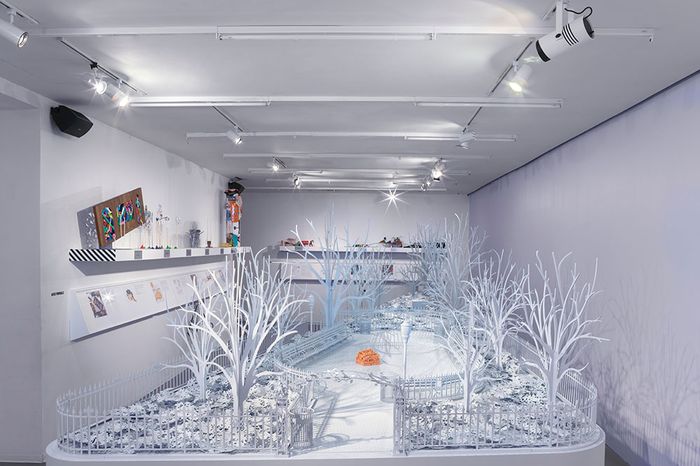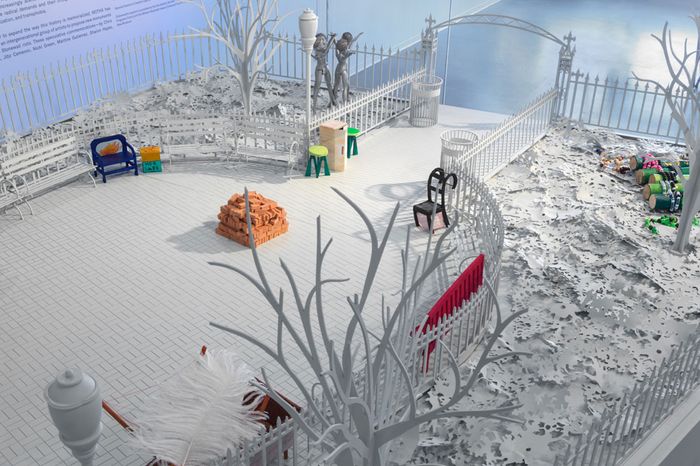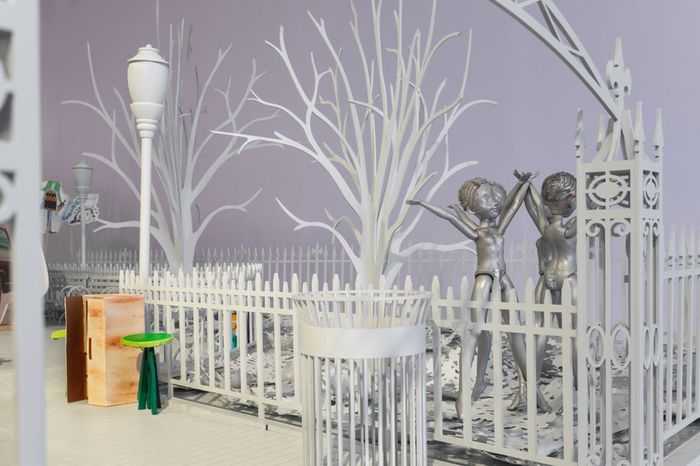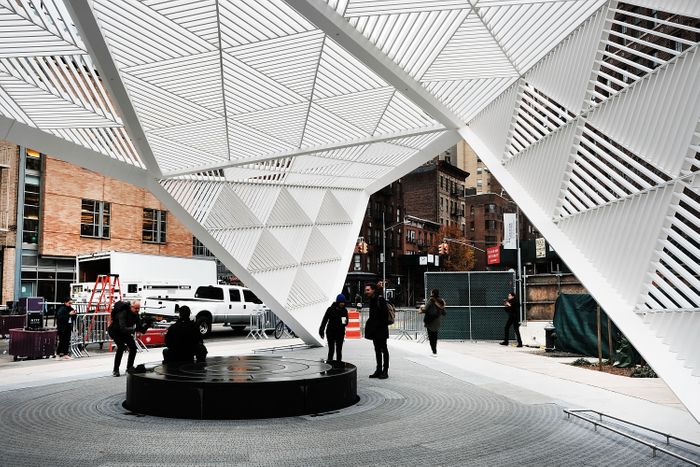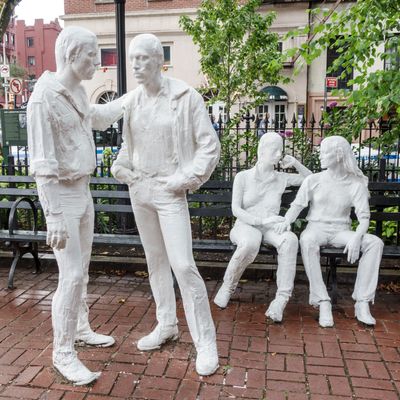
Public art has an impossible job. On Sunday afternoon I asked whoever happened to be in Christopher Park, across from the Stonewall Inn, hallowed site of that famous 1969 riot that is considered to have sparked the modern LGBTQ-rights movement, what they thought of “Gay Liberation.” It’s a low-key sculpture by George Segal of two same-sex couples relaxing — two women on a bench, two men, standing — cast in bronze and painted white, modeled after Segal’s friends, and installed in the park in 1992. Two friends, one black, the other white, drinking expensive coffee told me it was “nice,” especially for people who “might not know what happened.” An older white guy proclaimed it “hideous” and that “gay people should be much more creative.” A young black woman, a strategic adviser to a pharmaceutical company, told me she thought the figures should be more strident, while her friend said he liked the way they’re turning inward toward each other. A white middle-aged gay couple visiting from Dallas said they found it “beautiful” and “emotional,” going on to tell me they were also “moved” by Kinky Boots on Broadway the night before. Finally, a Latinx man from the Bronx, wearing a purple cowboy hat, red pants, and a shaggy goat-fur coat, asked me to take his picture sitting with the sculpture’s figures. “Be sure to get the Guccis,” he said, gesturing toward his sneakers. When I asked what he thought about the Segal, he tossed his head and said, “Honey, they’re just there!”
“Gay Liberation” was commissioned on the tenth anniversary of the riots, which were sparked by a police raid on the club (police harassment of gay clubs was then standard law-enforcement practice). The monument has been controversial since it was commissioned in 1979, though the nature of the criticism has changed over time. Initially fueled by outright homophobia, now the challenge comes from the other direction, by trans artists and activists of color. Building on a conversation around the politics of remembering and representation, a small exhibition at the New Museum, “Consciousness-Razing: The Stonewall Re-Memorialization Project,” takes up the criticism lodged at the existing monument and aims to propose alternatives.
Like Jerusalem’s Temple Mount, Stonewall’s meanings and histories are fiercely contested by several overlapping groups, with an intensity that leaves outsiders scratching their heads. Remember Roland Emmerich’s disastrous 2015 Stonewall film, which attracted ire by foregrounding the fictional “Danny,” a white corn-fed midwestern hunk. Many saw it epitomizing the decades of erasure trans women and people of color have experienced in the histories and representations of the LGBTQ movement. At the time of the film’s release, Miss Major Griffin-Gracy, who participated in the riots, reflected on what kind of monument she’d like to see there: “Put a couple of statues of people of color and at least make one of them an overly obnoxious transgender woman, 6’5”, three inch heels, blond/red hair, lashes, beads, feathers and put one of those fine white boys next to her, now that I can handle!” Heeding her call, two anonymous activists painted blackface onto the male figures, dressing them in wigs, scarves, and bras. A handwritten sign was propped by their feet: “Black and Latina trans women led the riots. Stop Whitewashing.” The incident signals a generational shift in the politics of representation and the fractures that the queer community is confronting as Stonewall’s 50th anniversary approaches next year.
Against this backdrop, conceptual artist Chris E. Vargas organized “Consciousness Razing,” under the auspices of his “semi-fictional” institution the Museum of Trans Hirstory and Art, or MOTHA (pronounced like the insect). Vargas started MOTHA in 2013 after observing the rising visibility of trans identities in the media, in what was later dubbed the “trans tipping point,” which brought mainstream fame to the likes of Laverne Cox, Caitlyn Jenner, and the television show Transparent. The last five years have likewise seen a major push by cultural institutions to populate their programs with events, panels, and exhibitions that include trans artists, which oscillates between feeling corrective and fetishistic — or both at the same time. Thus the idea of inventing a trans museum was a sly attempt to understand what was happening and try to help shape it with a bit more nuance. Vargas says he has a “complicated relationship” with this revisionist hypervisibility, which seems intent on defining and fixing the fluidity that encompasses so many different kinds of experiences under the name “trans.” “But that is what my project is about,” he tells me. “At its heart, I have to be engaged with institutions because MOTHA is about institutionalizing things, including this identity.” The New Museum in particular has been at the forefront of this move with its recent exhibitions “Trigger: Gender As Tool and Weapon” (2017), and the publication of the major anthology Trap Door: Trans Cultural Production and the Politics of Visibility (2018), both of which included MOTHA.
For this exhibition, Vargas invited 12 artists to propose new “liberation monuments” to replace George Segal’s. The selection represents an intergenerational mix of racially diverse artists who identify widely across the gender spectrum. Each proposal is displayed as a sketch and text pasted onto the walls, and small maquettes that get physically installed, one at a time, into a 1:7 scale model of the park, on weekly rotation. The pieces include everything from a Plexiglas Trajan’s column stuffed with lesbian-sloganed T-shirts (Catherine Lord), to a quartet of sheared and silvered Bratz dolls, meant to symbolize a racially ambiguous and gender-fluid every-person, asking you to recognize “those whom history has neglected” (Martine Gutierrez).
Nicki Green, an artist from San Francisco and a longtime MOTHA collaborator, proposes a pile of “Stonewall”-branded bricks heaped into the park. Passerby would be encouraged to take a brick to use however they see fit, until they disappear. This continues the ceramist’s work imagining “queer riot tools,” which includes handmade bottles for Molotov cocktails glazed in delftware designs and narrative depictions of trans history in the manner of ancient Greek pottery. Green previously made work memorializing the anniversary of San Francisco’s Compton’s Cafeteria riot in 1966, which was led by trans women, sex workers, people of color, and is often cited as one of the beginnings of trans activism. For the project, Green scoured thrift shops, anointing assorted dishes as long-lost relics and affixing commemorative logos on them. “As somebody who is invested in material culture, I think about how people would actually touch and interact with them, and how that sort of touch is a legacy-transmitting action. With the Compton’s dishes, I was thinking about the action of revolt — grabbing whatever is available and hurling things in the air.” She is similarly playing with the idea of the mythical “Stonewall brick,” which may or may not have started the riots.
Geo Wyeth, a New Yorker currently living in Rotterdam, proposes a “floating” graveyard party space, where the “muck” that has disappeared from our increasingly expensive city streets would be celebrated in an immersive environment. In 2013–2014, Wyeth made video work called “Quartered” exploring a relationship to their famous ancestor J. Marion Sims, the father of modern gynecology who refined his experiments on African-American slave women without anesthesia or consent. After much protest, a sculpture of Sims was removed from Central Park earlier this year, giving Wyeth another context to rethink monuments and their role in cultural memory. “There was a big debate going on in my family and I was included in an email thread, with a lot of people opposed to its removal,” they told me. “That was an amazing opportunity to explain why I am for removing it, and try to get them to think from another person’s perspective — asking, ‘Why are you so invested? What are you investing in?’” This informs their feelings about the Segal sculpture: “It’s inaccurate and that inaccuracy is racist — that is an omission,” one which, “misses the rage that has so much to do with life in the world as a queer person.”
The model park in the exhibition is professionally fabricated, complete with laser-cut detailing on the miniature wrought-iron fence, which contrasts the artists’ slapdash maquettes that look like a high-school project. (“Quick, it’s due tomorrow!”) While checking out Jibz Cameron’s piece, a series of crude drawings turned into small foam-core signs, one fell off its shelf and onto me. It read, “The toilets were overflowing.” The staff person who fixed it said the dowels were stuck into blobs of oil-based modeling clay that will never cure. In her text, Cameron (who also goes by the alter ego Dynasty Handbag) outlines an “obnoxious fountain with the drawings lining the sides (this would require a statue of some kind, which I am not prepared to decide on. Too much pressure!).” Anxiety to propose something as specific as a statute permeates the show, which skews toward abstractions, often bolstered by theoretical rejections of anything as definite as a monument.
The conceit of the current MOTHA show isn’t new. At the end of 2016, Avram Finkelstein and Hugh Ryan organized a feature for Vice called “Ten Queer Reimaginings of New York’s ‘Gay Liberation Monument.’” It brought together a similar intergenerational mix of racially diverse artists who identify widely across the gender spectrum, though their prompt was slightly different, creating responses to recontextualize the Segal rather than replace it outright. The results varied from Ken Gonzales-Day’s proposal to scatter sculptural corpses around the park to Carrie Moyer’s and Sheila Pepe’s photo-play satire of today’s middle-class lesbian life.
Before giving artists this task, Finkelstein had been thinking about how to reframe “Gay Liberation” for a long time. As a member of the collective that created the iconic “Silence=Death” poster, he envisioned a counter-monument back when the Segal was first installed. Between the sculpture’s commission in 1979, and its eventual placement in the park in 1992, AIDS had ravaged New York City and radicalized its queer communities. The white cast figures now seemed like ghosts, elegiac, and to AIDS activists, resigned. Finkelstein’s idea was for a kind of ACT UP monument: turning the signature pink triangle from “Silence=Death” into a pink triangular obelisk. The collective sent letters out to the business owners flanking the park asking if they’d support the intervention — there was no interest.
Even with its fatal political flaw, it’s important to recognize the virtues of Segal’s sculpture. Life casting is an extremely basic way of making an object by creating a mold from a real thing, removing it to leave a hollow negative, and then filling it with new material to create a copy. The results are both direct and indirect simultaneously, linked through an unbroken chain of touches. Segal developed a process of wrapping subjects in strips of plaster-drenched cloth, clinging tightly to the body through their clothes — aping the effect of fabrics in Hellenistic marbles without their preternatural grace. With human figures, the life cast displaces the same volume as a body, and we respond to that on a physical level, uncannily, because we know the living original is gone. Bodies change and die, but the cast remains, a record of someone who once was, at a specific point in time. The choice to paint them white further separates these sculptures from the life, even as they bleed seamlessly into the surrounding world — sitting or standing in the same place you are, without plinth or barrier. (The bench that curves around the park is also a part of the sculpture.) The choice of color relates to his process of plaster casting, but it also feels haunted, making you think of people who were alive and now aren’t, observing the bodies of everyone else in the park doing their own thing, and imagining who has been there before. As a further intervention into the rhetoric of monuments, these figures are just living their lives, being together, without doing anything heroic — a gentle tableaux you can walk into. It becomes part of your life. In its way this enacts a utopian ideal, where queer people are just in the world like everyone else. It’s fascinating to see how often people touch them, which is constantly — mostly affectionately, sometimes lewdly, though generally it’s just a gentle laying on of hands the way the figures do to each other. All of this makes “Gay Liberation” one of the most effective public art works in New York, and for its clarity and subtlety, one of the best sculptures Segal ever made.
Jonathan Kuhn, current director of Art and Antiquities for the city of New York, oversaw the installation a year after starting his new job in 1991. “One of the biggest challenges is realizing something in physical form that sustains us, has impact, and is of the stature of the subject being commemorated,” he says, “None will be perfect. We cannot possibly ask any work of art to convey all the complex emotions we have about a person, place, event, or movement.” He tells me about the shifts in perception around it, that by 1992 it was contextualized by AIDS, which was not part of its intention when it was made in 1979; it then seemed to embody the legalization of gay marriage in 2015; after the Orlando nightclub shooting in 2016, it became a shrine, surrounded with flowers, candles, and signs. “We assume with any monument that its creation represents a specific moment in time,” he says, “and it’s understood that it stays stable, literally, when the world around it changes.” As a special subcategory of public art, monuments have a special if doomed task of coalescing publics around them — embodying our shared civic values. Of course, in an America as bitterly divided as ours, the idea of a “monument” — to anything, in any form — is all but unthinkable.
As a point of comparison, take the “New York City AIDS Memorial,” which opened a short walk up Seventh Avenue from the Stonewall Inn across from what was St. Vincent’s hospital, which took in the earliest AIDS cases when other hospitals refused. St. Vincent’s set up the first AIDS ward in the city, and the second in the nation, in 1984, and remained ground zero for the plague — it’s where the angel bursts through the roof in Angels in America. By the time the hospital was demolished in 2010, to make way for very expensive condos, the once inexplicably horrific disease had become largely controllable through drug therapy, and the condo developer agreed to also pay to remake the park as an AIDS memorial, which is a powerful gesture, even as the crisis itself is ongoing.
For the memorial, the architecture firm Studio AI designed an off-white trellislike canopy of interlinked triangles. The shape is intended as an homage to the “Silence=Death” image that became an emblem of ACT UP and AIDS activism more broadly. ACT UP’s solid pink equilateral reclaimed the Nazi concentration-camp signifier identifying homosexuals. The color itself was specific, consciously punched-up by the collective to be a strong, saturated magenta. The use of triangles in the canopy, which includes several non-equilateral varieties, uncoupled from color, is drained of any symbolic meaning: It feels like tasteful urban furniture, quite the opposite of what the AIDS activists were fighting for, and the methods they deployed so effectively.
The same goes for the text engraved on the pavers beneath it, for which artist Jenny Holzer excerpted Walt Whitman’s “Song of Myself.” The choice of poem, however beautiful, is a head-scratcher: Were there no artists or writers affected by the AIDS crisis who could offer a more appropriate text? Nothing by Tim Dlugos or Essex Hemphill or Karen Finley or Audre Lorde was fitting, or more specifically relevant for honoring the creative sectors of New York City decimated by the disease? More problematic is the way the text is arranged in a tight concentric circle, which makes it impossible to sustain reading from one line to the next — the result is a visual murmur, a pattern, like the triangles enclosing it. Using a poem should be dictated by the power of those exact words, and made legible for that reason — they are being set in stone after all. The entire effect is uninspired, like a Maya Lin knockoff, thinking of her “Civil Rights Memorial” (1989) or “Women’s Table” (1993), both of which avoid these pitfalls through the precision of language and its relation to form. But it is probably what the condo developers wanted: something vague in a corporate way, nothing too angry, sad, or specific that might disturb property values.
Much of the criticism leveled at Segal’s “Gay Liberation” relates to his use of figures — and using specific people to symbolize an abstraction will always cause trouble. It’s undeniable how powerful it would be to see a black trans women “just living” in the utopian future it imagines. The prevailing discourse around queer representation, however, skews heavily toward the safety of abstraction, and as the “New York AIDS Memorial” shows, abstraction on its own isn’t the promised panacea. What is missing from the rigorous political critique that drives the MOTHA proposals, or the imperatives that produced the NYC AIDS memorial, is an equally rigorous engagement with aesthetic form. It’s the problem of “art” in public art, which is too often disregarded as a luxury we cannot afford, instead of being understood as the essential reality of how any of these interventions materialize, communicate, or make meaning at all. Monuments are one way we anchor the fluidity of our cultural memory, even as our needs for them are always shifting, invalidating, and revising their meanings. In a city like New York, where public space is increasingly dominated by private capital, there is a new urgency to think about how we can represent and remember human life within it. Artists must relentlessly push the boundaries of this conversation, finding new ways to reconcile the broken halves of the illusory promise of “public art.”


